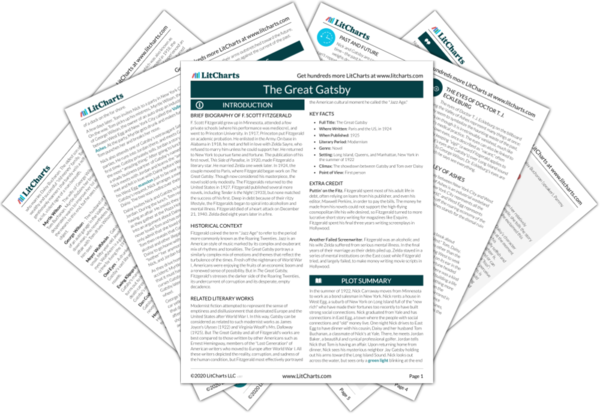Summary
Analysis
Nick describes a "waste land" between West Egg and New York City where the ashes from the city are dumped. The ashes cover everything, including the men who live there. Above this bleak "Valley of Ashes" stare out two huge spectacled eyes from a billboard for an eye doctor's defunct practice. These haunting, unblinking eyes of Doctor T. J. Eckleburg watch over everything in the Valley of Ashes.
The "Valley of Ashes" represents the people left behind in the Roaring Twenties. The dust recalls Nick's reference to the "foul dust" that corrupted Gatsby. Eckleburg's eyes witness the bleakness, and represent the past that the 1920s wasted.
Themes
Literary Devices
Quiz
Test Yourself
One day, as Tom and Nick ride a train from Long Island into the city, Tom gets off at a stop in the Valley of Ashes and tells Nick to come along. Tom leads Nick to George Wilson's auto garage, and Nick learns that Tom's mistress is Wilson's wife, Myrtle. Wilson is good-looking, but beaten-down and lifeless and has ashes in his hair, while Myrtle strikes Nick as vibrant and oddly sensuous. Tom talks with Wilson about selling a car. When Wilson goes to get some chairs, Tom whispers to Myrtle to meet them in a little while at the train station.
The old money represented by Tom uses the "no money" people while pretending to help them. Wilson and Myrtle have different reactions to the world that has left them behind. Wilson is left weak and defeated, with vague dreams he can't fulfill. Myrtle wants desperately to be a part of the world she sees but can't touch, and so takes up with Tom.
Themes
Quiz
Test Yourself
Tom, Myrtle, and Nick go to the apartment Tom keeps in New York City to conduct his affair. Myrtle's sister Catherine soon shows up, as does another couple. Everyone gets very drunk, including Nick. He says the party is only the second time he's been drunk.
The drunken party shows both the "fun" and hidden desperation of the Roaring Twenties. Getting drunk, it seems, is the only thing making the party fun, or at least bearable.
Themes
Quiz
Test Yourself
The topic of conversation eventually turns to Nick's neighbor Gatsby. Catherine says she's afraid of Gatsby because she's heard that he's a relative of the German emperor, Kaiser Wilhelm, and everyone agrees that Gatsby is involved in some sort of shifty business.
Rumors swirl around Gatsby. He has become so rich and is so mysterious he seems almost hollow—all surface and no substance.
Themes
Literary Devices
Quiz
Test Yourself
Get the entire The Great Gatsby LitChart as a printable PDF.

As Myrtle gets more and more drunk she also gets increasingly loud. After Tom gives her a puppy as a gift, she starts talking about Daisy. Tom warns her that she doesn't have the right to use Daisy's name. But she starts to tease him by repeatedly calling out "Daisy! Daisy! Daisy!" Tom punches her in the nose, breaking it. The party ends, and Nick takes the train home alone.
Tom's degrading treatment of Myrtle reveals the cruel side of his privileged "old money" upbringing. His "loyalty" to Daisy also reveals his hypocrisy: he's cheating on her.
Themes
Literary Devices
Quiz
Test Yourself












